Vibrant and elegant, Spain captivates with its untamed beauty, rich history, and unforgettable cuisine. Life here is a celebration—and everyone’s welcome to join.
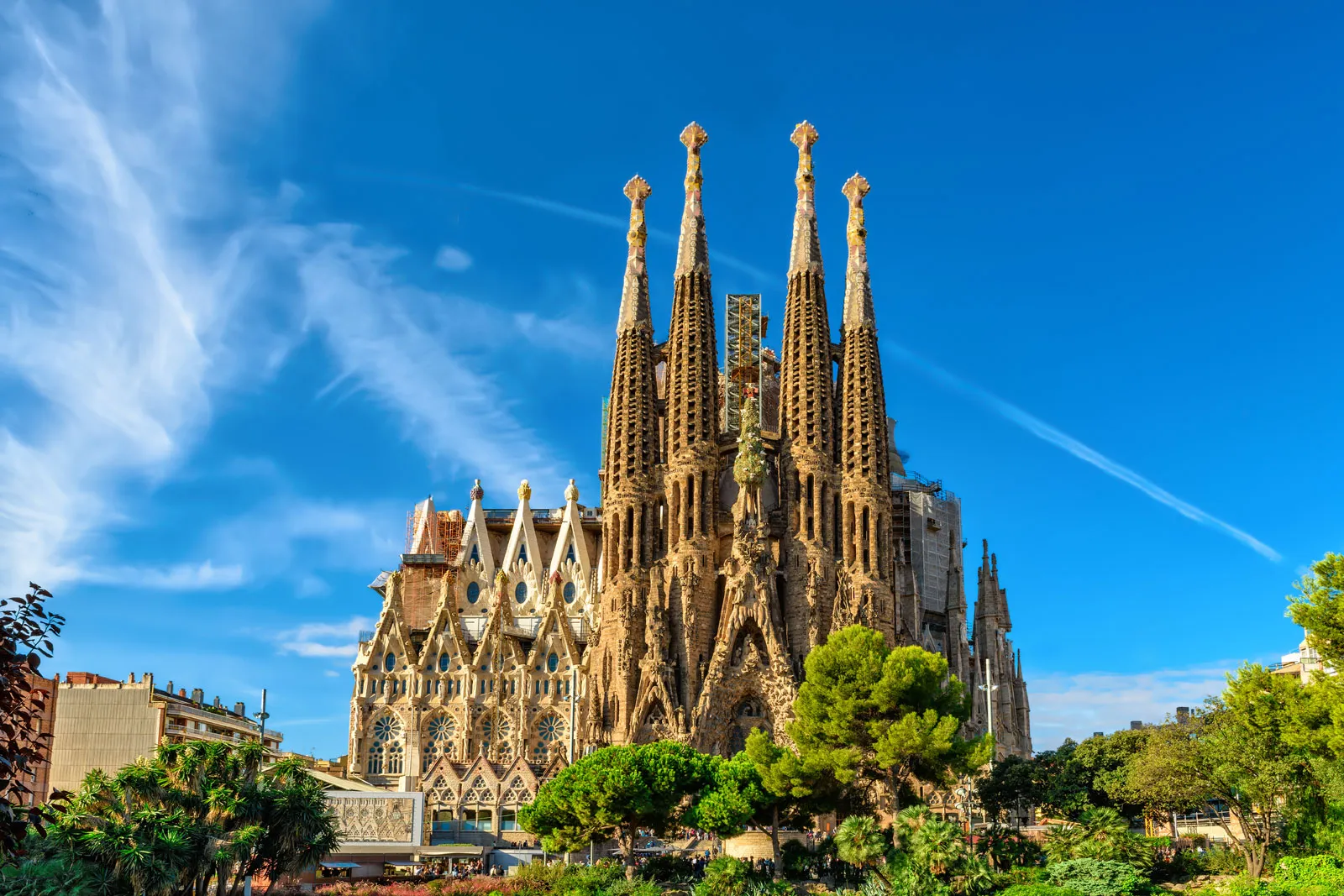
The Temple Expiatori de la Sagrada Família is widely regarded as the emblem of Barcelona. For many, it’s the one landmark that simply can’t be missed when visiting the Catalan capital.
Originally envisioned as a modest Roman Catholic church dedicated to Jesus, Mary, and Joseph, it has since evolved into the most iconic example of Catalan Modernism. In 2010, Pope Benedict XVI elevated it to the status of a basilica.
Designed by legendary architect Antoni Gaudí, the basilica reflects his belief that nature is God’s creation. Gaudí combined Christian themes and biblical allegories with organic forms inspired by nature, which can be seen in every column, pinnacle, and stained glass window.
Despite being unfinished and under construction for nearly 140 years, the Sagrada Família stands as a breathtaking architectural masterpiece and is one of Spain’s most visited landmarks—welcoming 4.7 million visitors in 2019.
The story of the Sagrada Família is a living timeline of devotion, creativity, and resilience.
It began in 1882, when local bookseller Josep Maria Bocabella initiated the idea of a temple dedicated to the Holy Family. The original design, by Francisco de Paula del Villar, was neo-Gothic, but disagreements led to Antoni Gaudí taking over the project.
Gaudí’s vision was radically different. He aimed to illustrate the life of Jesus through three main façades: Nativity, Passion, and Glory, all while embedding natural symbolism into every element of the structure.
By 1891, with work on the Nativity Façade underway, Gaudí realized he wouldn’t live to see the project’s completion. He focused on the exterior to ensure the church would serve its purpose of worship. After finishing Casa Milà in 1912, Gaudí dedicated himself solely to the Sagrada Família until his death in 1926. He is buried in its crypt.
The Spanish Civil War (1936–1939) brought tragedy when anarchists set fire to Gaudí’s workshop. Much of his work was destroyed, though some materials were saved. Construction resumed in 1954 and has continued ever since.
Even today, Gaudí’s intricate design poses a major challenge to architects and engineers. Creating the complex shapes and geometry envisioned by Gaudí is no easy task.
Funding has always been a challenge, as the project relies solely on private donations. Work stalled during the Civil War and the decades following, only picking up pace after Barcelona hosted the 1992 Olympics, boosting international tourism.
The Sagrada Família was set for completion in 2026, marking Gaudí’s centenary, but delays caused by the COVID-19 pandemic have pushed back the timeline. A new completion date has not yet been confirmed.
The site consists of four main areas:
The Basilica
The School Building
The Gaudí Museum
The Towers
Currently, only the basilica is open due to health measures.
Basic entry (with audio guide): €26
Guided tour + individual access afterward: €27
Audio guides are available in 16 languages; tours in 6 languages.
Highlights:
The Basilica: Five naves forming a Latin cross supported by tree-like angled pillars, creating a forest-like interior with dappled light.
Gaudí Museum: Contains reconstructions of Gaudí’s workshop, models, and design materials.
School Building: Built in 1909 for workers’ children, similar in style to Casa Milà.
The Towers: Each façade (Nativity, Passion, and Glory) features four towers representing the apostles. The Nativity Façade, built by Gaudí, is a UNESCO World Heritage Site. The Passion Façade is more abstract and modern, while the Glory Façade is under construction and expected to be the most impressive.
The Sagrada Família is located in the Eixample district, at 401 Mallorca Street.
You can reach it via Metro lines 2 or 5, which stop at Sagrada Família station.
It’s also about a 30–40-minute walk from Barcelona’s Old City.
The basilica is open daily, although hours may vary due to special events.
To avoid crowds, weekday mornings are best.
Plan to spend 2 to 3 hours for a complete visit.
After your visit, explore nearby landmarks in the Right Eixample:
Hospital de Sant Pau – Another stunning example of Catalan Modernism, designed by Lluís Domènech i Montaner.
Monumental – A striking former bullfighting arena.
Arc de Triomf & Parc de la Ciutadella – A picturesque walk along Passeig de Lluís Companys leads you to Barcelona’s largest park.
Restaurants near the basilica are mostly tourist-focused, but walk a few blocks and you’ll find local favorites in l’Eixample:
Hasta Los Andares – Tapas and Spanish wine
La Granota – Known for classic Spanish tortillas
Olé Mallorca – Serves hearty Catalan dishes (great for lunch between 2–3 PM)
Puiggròs – A century-old patisserie perfect for a morning treat
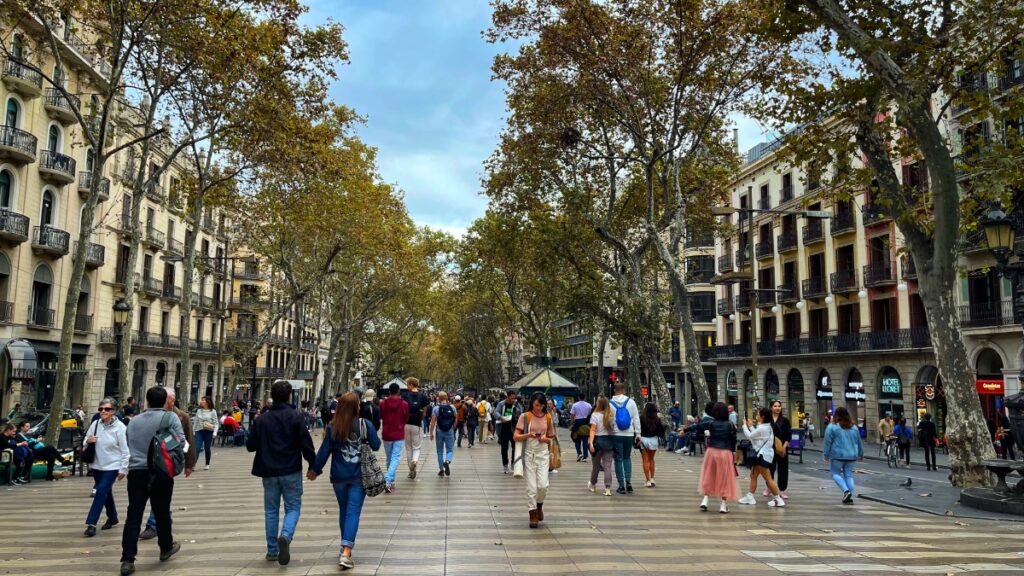
La Rambla is a tree-lined boulevard featuring a wide array of architectural delights, beautifully decorated flower stalls, and particularly talented (and certified) human statues. Foodies will definitely enjoy the tapa joints at Mercat de la Boqueria, considered by many to be the best gourmet food market in Europe.
It is infamous for the incredible number of pickpockets and tourist-first restaurants serving mediocre paella, but there is still plenty to see and appreciate.
Linking Plaça de Catalunya, the central square in Barcelona, with the old harbor, strolling La Rambla—or ramblejar, as the locals say—while admiring the imposing facades and doing some people watching, is something everyone should experience when visiting Barcelona.
Unlike most landmarks in Barcelona, the history of La Rambla is neither epic nor glamorous.
Its name comes from the Arabic word “ramla”, which translates into “sandy or muddy area”. Today’s La Rambla used to be an open sewer named Riera d’en Malla, which also served as a natural culvert for water coming from the Collserola hills.
In the 15th century, the Barcelona Council wanted to extend the city walls to include El Raval district. To do that, they diverted the stream to flow outside the walls. The emptied area became the actual street later named La Rambla. Over time, several convents and monasteries were built along La Rambla, but most were burnt down during the anti-clerical revolution of 1835.
It wasn’t until then that La Rambla began to flourish. Major landmarks such as Plaça Reial, Mercat de la Boqueria, Teatre Liceu, and Font de Canaletes were all built in the 19th century on ground where Catholic buildings once stood.
Soon, La Rambla became the heart of modern city life in Barcelona.
With the arrival of mass tourism, however, it turned into the city’s busiest tourist area, losing the local essence that once defined it. Locals became rare, and the area was hit hard by the effects of COVID-19. Restaurants on the boulevard tried to attract locals back with big discounts, but it had already been too long since they considered it part of their regular routes.
You might hear some locals call it La Rambla, while others say Les Rambles. Both are correct.
La Rambla refers to the whole pedestrian boulevard. Les Rambles, the plural form, refers to the five different sections that make up the street. These sections can help guide your walking tour.
The first stretch is La Rambla de Canaletes, home to the Font de Canaletes. A local legend says that if you drink from this fountain, you will return to Barcelona. It’s also where FC Barcelona fans gather to celebrate big wins. Walking further, you’ll find Església de Betlem, a 17th-century baroque church that survived the anti-clerical revolution.
The second stretch, La Rambla dels Estudis, is named after the Estudi General de Barcelona, a 16th-century university that preceded the Universitat de Barcelona.
Art lovers will enjoy La Rambla de les Flors, the third section, which features a mosaic by surrealist painter Joan Miró and the neoclassical Virreina Palace. The flower market, active since the 19th century, is located here, along with a memorial for victims of the 2017 terrorist attack.
Next is La Rambla dels Caputxins, named after a former Capuchin monastery. This section is home to El Mercat de la Boqueria, known for its fresh produce and vibrant food scene. Stop at Pinocho Bar, an award-winning tapas bar famous for dishes like calamarcets amb mongetes de Santa Pau (little squid with white beans). Across the street, you’ll find the Erotic Museum, which explores the history of sexuality in Barcelona.
The final section is La Rambla de Santa Mònica, named after another monastery destroyed in 1835. At the southern end stands the 60-meter Columbus statue, overlooking the old harbor.
Plaça Catalunya metro (Lines 1, 3 and FGC) is at the northern edge of La Rambla, considered its starting point.
Liceu and Drassanes metro stations (Line 3) are located mid-way and at the southern end of the boulevard, respectively.
La Rambla runs through the Old City, separating the Gothic Quarter and El Raval.
In El Raval, you’ll find the Museum of Contemporary Art, one of the most visited museums in Barcelona. La Rambla del Raval, a quieter side street, is also home to a large cat sculpture by Colombian artist Botero.
The Gothic side is filled with beautiful Gothic and neo-Gothic architecture. The Barcelona Cathedral is particularly breathtaking.
North of La Rambla and Plaça Catalunya is Passeig de Gràcia, a luxurious avenue featuring Gaudí’s La Pedrera and Casa Batlló.
At the southern end, La Rambla leads to the harbor and connects to the beachside district of La Barceloneta.
Besides some notable tapas joints in Mercat de la Boqueria, it’s best to skip restaurants directly on La Rambla. Instead, explore the nearby Gothic Quarter and El Raval for authentic dining.
In the Gothic area, try Agut for traditional Catalan dishes or Neri for a more modern experience. Babia is a good choice for classic Spanish tapas.
In El Raval, Arume offers Galician specialties, including famous octopus dishes. Bar Cañete is a traditional Spanish spot with a long history, while Buenissimo Burger is great if you’re in the mood for something different.
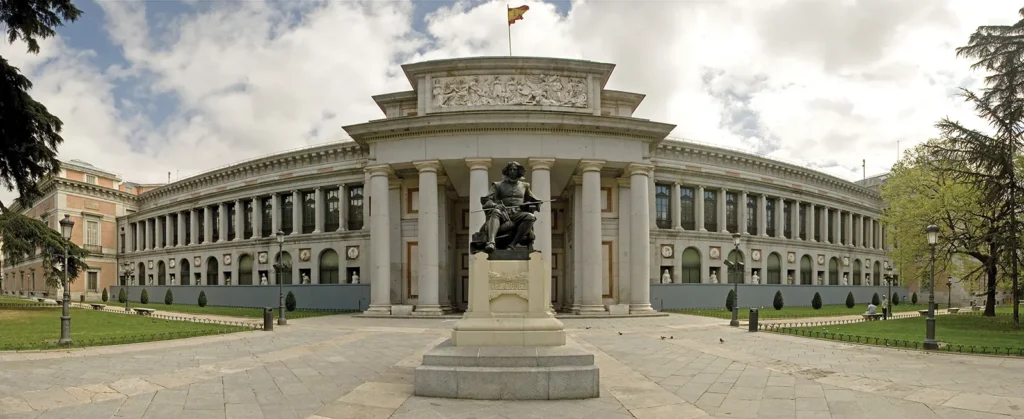
The Prado is one of the most impressive art museums in the world. Located on the Paseo del Prado in Madrid’s famous “Golden Triangle of Art”, this grand museum showcases a wide range of European masterpieces, from the medieval era to the early modern period.
The museum is especially known for its Spanish artists. Works like Velázquez’s mysterious Las Meninas and Goya’s haunting Black Paintings draw visitors from around the world. Other renowned artists on display include Rubens, El Greco, Bruegel, Dürer, Raphael, Caravaggio, and Rembrandt.
To enjoy the Prado fully, set aside a full day and plan your visit. Rather than trying to see everything, choose a few highlights and allow time to explore lesser-known pieces. Grab a floor plan at the entrance and select artworks from the highlights list. This approach ensures a relaxed and meaningful visit.
Insider Tip
If the crowds become overwhelming, visit room 51C on the ground floor. Here you’ll find 12th-century frescos from Spanish hermitages. A standout is the Mozarabic artwork from the Hermitage of San Baudelio, offering a rare look at Christian art influenced by Muslim rule during the time of Al-Ándalus.
Three Ways to Experience the Prado
If you have 30 minutes
Head to the first floor to see Las Meninas by Velázquez, one of the museum’s most famous paintings. At first glance, it looks like a royal portrait of young Infanta Margarita. But a closer look reveals the painter himself in the scene, quietly observing from the shadows. In the mirror above Margarita, you can spot the reflections of King Felipe IV and Queen Mariana. Is Velázquez painting them? The painting leaves room for interpretation.
Nearby, you can also see works by El Greco, Rubens, Titian, and Jusepe de Ribera. Ribera’s dramatic portraits of saints, highlighted against dark backgrounds, show why he is considered one of the greatest painters of the 17th century.
If you have 90 minutes
After exploring the first floor, head downstairs to see Bosch’s Garden of Earthly Delights, a fascinating triptych full of surreal imagery and symbolism. Painted around 1490–1500, the central panel features nude figures in a wild, fantastical world. Though once thought to celebrate freedom, it’s more likely a moral warning, with sinners meeting their fate in the hellish right panel.
Nearby is a portrait of King Felipe II by Sofonisba Anguissola, one of the few celebrated female artists of her time. Other highlights in this area include Bruegel’s Triumph of Death, Dürer’s Adam and Eve, and Van der Weyden’s The Descent from the Cross.
If you have half a day
The Prado’s three must-see works are Las Meninas, The Garden of Earthly Delights, and Goya’s Black Paintings in room 67. These pieces remain powerful and relevant today.
Goya’s later paintings mark a dramatic change in style. After years as a court painter, he became nearly deaf and retreated from public life. Living in the Quinta del Sordo (House of the Deaf Man), he painted disturbing scenes on the walls, reflecting his personal trauma and the horrors he witnessed during the French invasion of Spain. Two particularly memorable pieces are Saturn Eating His Son and Drowning Dog.
If the mood becomes too heavy, visit works by Joaquín Sorolla before you leave. His bright, light-filled paintings offer a beautiful contrast.
A Brief History of the Prado
The Prado building was originally intended to be a science museum. Construction began in 1785 but was interrupted when Napoleon’s army took it over in 1808. After King Fernando VII reclaimed the throne, the unfinished building was converted into an art museum to house the royal collection. It opened to the public in 1819.
Tickets and Tips
To avoid lines, buy your ticket in advance from the official Prado website. General admission, including special exhibits, costs €15. Guided tours by museum staff are available for €10, and an audio guide is €5. A Prado app is available, but most features require in-app purchases.
The museum is busiest midday. Visit early (at 10 am) or during the quieter 3 pm period. Free entry is available in the evenings (6 to 8 pm, or 5 to 7 pm on Sundays), but expect long lines.
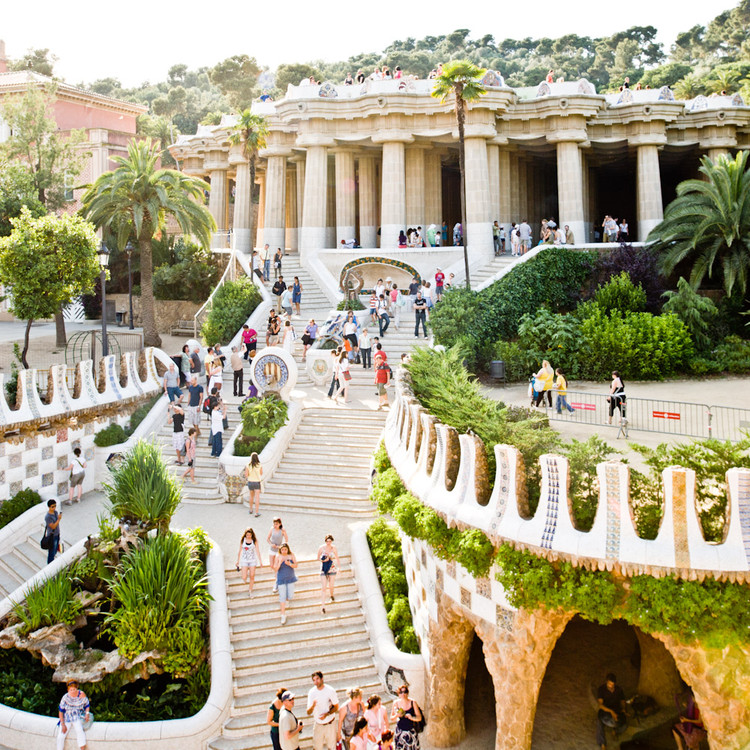
Park Güell is one of Barcelona’s most iconic landmarks, blending artistic design with natural surroundings. Designed by Antoni Gaudí, the park features colorful mosaics, curved architectural forms, and wide views of the city and the Mediterranean Sea. Originally planned as a private residential community, the project evolved into a public park and is now recognized as a UNESCO World Heritage Site.
Monumental Zone: Features Gaudí’s most famous works including the dragon fountain, Sala Hipòstila (a hall of 86 stone columns), and the mosaic bench with panoramic views.
Gaudí House Museum: One of only two houses built in the project. Gaudí lived here from 1906 to 1925.
El Calvari: The park’s highest point at 182 meters, offering impressive city views and a monument with three crosses.
Forest Zone: A large public space with walking trails and shaded paths, free to enter.
In 1900, Count Eusebi Güell commissioned Antoni Gaudí to design a residential estate inspired by British garden cities. The project, named Park Güell, was not commercially successful and only two homes were completed. By 1926, the site was opened to the public, and in 1984 it was declared a UNESCO World Heritage Site for its architectural and cultural significance.
General admission: 10 euros
Guided tour: 22 euros
Private tour: 50 euros
(Ticket prices may vary)
It is strongly recommended to purchase tickets online in advance. Entry to the monumental zone is timed, and visitors must enter no later than 30 minutes after their scheduled time. The forest area of the park remains open and free to the public. The Gaudí House Museum requires a separate ticket.
Weekdays at 9:30 am, when the park opens, are the best time to visit to avoid crowds and enjoy a peaceful experience.
From Lesseps metro station (Line 3), it is a 15-minute walk to the main gate on Carrer d’Olot.
From Vallcarca metro station (Line 3), it is also a 15-minute walk, entering from the west side of the park.
Visitors staying in Gràcia or Sant Gervasi can reach the park on foot in about 20 to 30 minutes. Walking from the Old City is not recommended.
Gràcia is known for its cozy and affordable local restaurants.
La Pubilla: Well-known for traditional Catalan dishes.
Bar Bodega Quimet: Offers homemade tapas in a relaxed setting.
Vermuteria Puigmartí: Serves creative modern tapas in a stylish environment.
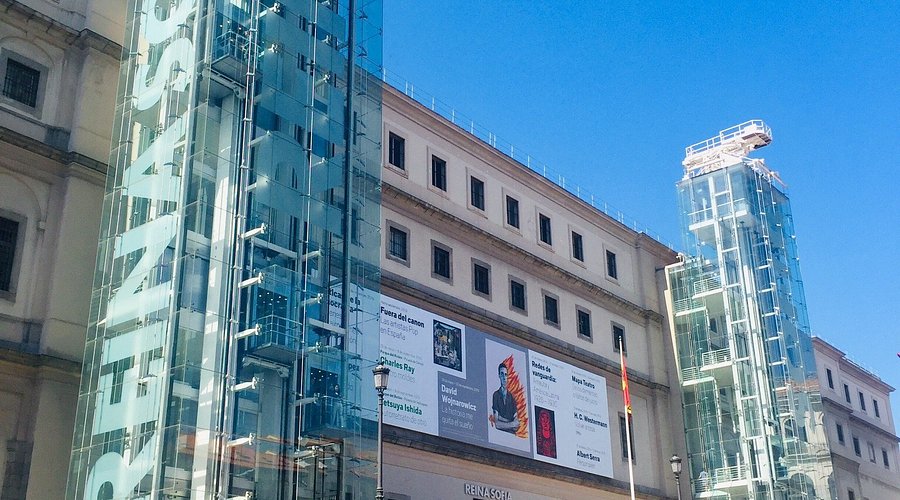
Part of Madrid’s renowned golden triangle of art museums, the Reina Sofía houses one of the world’s most significant collections of modern and contemporary art. The museum focuses primarily on Spanish artists, and its star attraction is Picasso’s Guernica, a powerful anti-war masterpiece.
Beyond Guernica, the collection traces the turbulent artistic and political journey of 20th-century Spain. Key figures featured include Salvador Dalí, Joan Miró, and Pablo Picasso, alongside select works by international artists such as Man Ray, Francis Bacon, and George Grosz.
Architecture
The museum is set in the grand Edificio Sabatini, a former hospital from the 18th century, located just off the Paseo del Prado. Attached to this is the Edificio Nouvo, a striking modern extension in deep red tones. It includes a library, museum shop, and café, and dramatically frames Roy Lichtenstein’s Brushstroke sculpture in the central courtyard.
Start with Guernica
Most visits begin with Guernica, located in Room 205 on the second floor. Take the lift to the second floor and follow the signs. The painting, created in response to the bombing of the Basque town of Gernika during the Spanish Civil War, remains one of the most iconic political artworks of the 20th century.
Insider Tip
If you’re visiting on a hot or rainy day, it’s more comfortable to queue for tickets at the Edificio Nouvo side, as the roof provides shelter.
If you have 30 minutes
Head directly to Room 205.10 to view Guernica. Accompanying sketches and studies by Picasso surround the main work, giving insight into its creation. Also nearby in Room 205.06 is Ángeles Santos’s Un Mundo (A World), painted at age 17. This surreal, cosmic canvas serves as a compelling counterpoint to Picasso and shows the contribution of female artists during this era.
If you have 1.5 hours
Before seeing Guernica, explore the path leading to it. In Room 204.01, you’ll find cubist works by Georges Braque, Juan Gris, and early Picasso. In Rooms 205.15 and beyond, you can immerse yourself in surrealism, with notable pieces by Dalí, Miró, Magritte, and Ernst. Recommended highlights nearby include Dalí’s Invisible Man (Room 206.03), Miró’s Man with a Pipe (Room 206.02), and Picasso’s Woman in Blue (Room 201.2).
If you have half a day
Stay on the second floor to understand the historical and cultural backdrop through documentary photography, posters, and Civil War artifacts. In Room 208.02, learn about the war’s origins, and in Room 205.5, see a colorful wall of propaganda posters from the conflict era.
Move up to the quieter fourth floor to explore post-war Spanish art. Discover works by lesser-known artists such as Joan Ponç’s Composició (Room 400.05), Pancho Cossío’s Portrait of Ramiro de Ledesma (Room 400.01), and Francisco Nieva’s avant-garde work on Postism (Room 400.04). This floor also features South American art, including strong pieces by Diego Rivera in Room 405.
Originally built as a hospital in the 18th century, the structure remained unused from 1961 until its transformation into a museum in 1990. During renovations, the mummified remains of three nuns were discovered in the old chapel, contributing to lingering stories of the building being haunted.
Entry: €12 for a single day, €18 for a two-day pass
Free admission:
Sunday from 12:30 pm to 2:30 pm
Daily from 7 pm to 9 pm (except Tuesdays)
Closed on Tuesdays
Free guided tours available in English and Spanish:
30 minutes for general orientation
90 minutes focused on Guernica
Navigation tips
The museum no longer provides paper maps. To avoid confusion, download a digital map in advance or consult the floor plans displayed inside. If you’re looking for a specific artist, use the museum website to locate the correct room number and cross-reference it with the floor plan.
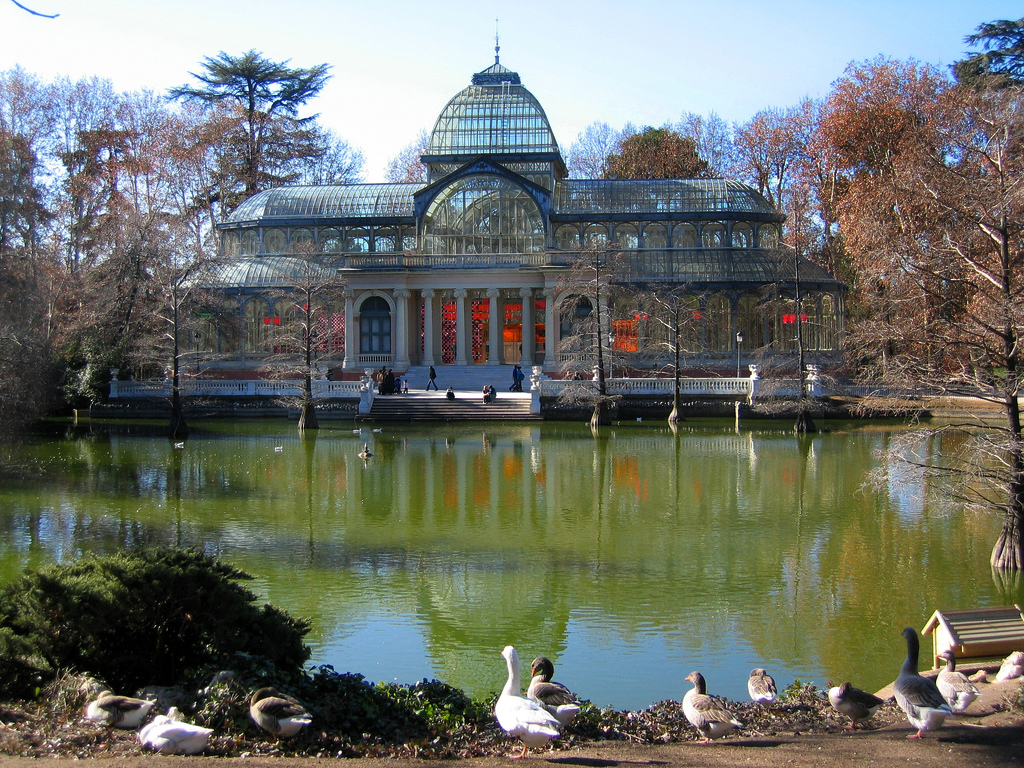
Once a private haven for Spanish royalty, Parque del Buen Retiro is now a vibrant 292-acre green space at the heart of Madrid. Popular for its festive weekend atmosphere, the park comes alive with dancers, skaters, cyclists, and families enjoying the outdoors.
Estanque Grande: Central boating lake with views of the grand Monument to King Alfonso XII.
Jardín Parterre: Elegant topiary garden home to Madrid’s oldest tree, a 17th-century Mexican Ahuehuete.
Paseo de las Estatuas: Avenue lined with statues of Spanish monarchs.
Palacio de Velázquez & Palacio de Cristal: Free-entry art galleries, both part of the Reina Sofía museum.
Rosaleda Garden: A romantic rose garden in bloom from May to June.
El Ángel Caído: The world’s only public statue of Lucifer, standing precisely 666m above sea level.
Hidden Gems: Explore the eastern side for fewer crowds, an artificial mountain with city views, medieval ruins, and peacocks in a walled garden.
30 minutes: Enter via Puerta de Felipe IV, visit Jardín Parterre and Paseo de las Estatuas.
90 minutes: Enjoy the lake, hire a boat, visit nearby monuments and Palacio de Velázquez.
Half-day: Add Palacio de Cristal, Rosaleda Garden, and El Ángel Caído for a fuller experience.
Established in the 17th century by King Felipe IV for leisure and spectacle, Retiro was a palace of pleasure with naval reenactments on the lake. Though much was destroyed during the Napoleonic invasion, surviving buildings and grounds reflect its royal legacy.
Open: Daily from 6am. Closes at 10pm (autumn/winter) and midnight (spring/summer).
Free Entry: Park access and galleries.
Getting Around: Rent a bike, scooter, or join an English-language Segway tour from Retiro Magic.
Note: Park may close in high winds for safety.
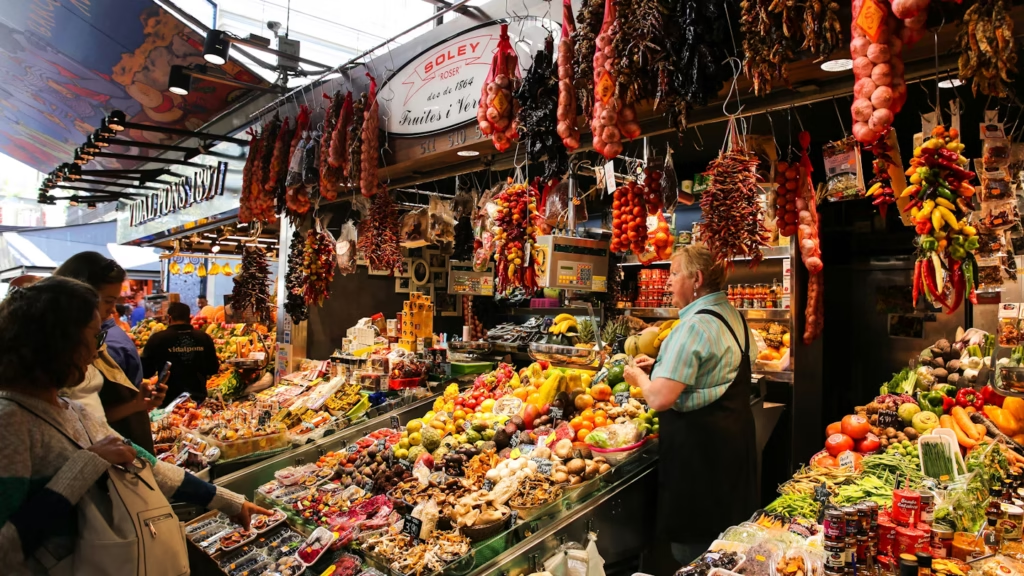
Nestled on the plane-tree-lined La Rambla, La Boqueria is Barcelona’s oldest and most iconic market, boasting over 800 years of history and a vibrant atmosphere. Overflowing with fresh local produce—from pungent cheeses and salt-tanged seafood to ripe tomatoes—this bustling market blends centuries-old family businesses with lively tapas bars, offering a true taste of Catalan gastronomy.
Housed in a striking 1840 Modernista building, with a colorful stained-glass gate and metal roof, La Boqueria remains a magnet for both locals and tourists. Despite recent overtourism challenges, the Business Owners’ Association is revitalizing the market’s local roots through gastronomic pop-ups and new specialized stalls.
Where to Eat:
El Quim de la Boqueria is a beloved tapas bar known for dishes like fried eggs with cuttlefish and Iberian ham-topped bombas.
Direkte Boqueria offers innovative Catalan-Asian fusion tasting menus sourced fresh daily from the market stalls.
What to Buy:
Avoid tourist-heavy areas to find authentic local products such as fuet sausage from Vic, Iberian jamón, Catalan olive oil, wild mushrooms, and unique seafood like Galician percebes. Don’t miss artisanal cheeses from Catalonia and northern Spain, or seasonal specialties like chargrilled calçots with romesco sauce.
Practical Info:
Open Monday to Saturday, 8am–8:30pm. Early mornings are best to avoid crowds and shop like a local. Most stalls accept cards, but carrying cash is useful. The market’s website provides a detailed stall map, helping visitors navigate its bustling labyrinth. For a deeper experience, consider food tours or cooking classes that start with a market visit and end in a nearby kitchen.
Insider Tip:
Explore other Barcelona markets like Mercat de la Llibertat in Gràcia or the historic Mercat de Sant Antoni for more fresh produce, traditional dishes, and a taste of local life.
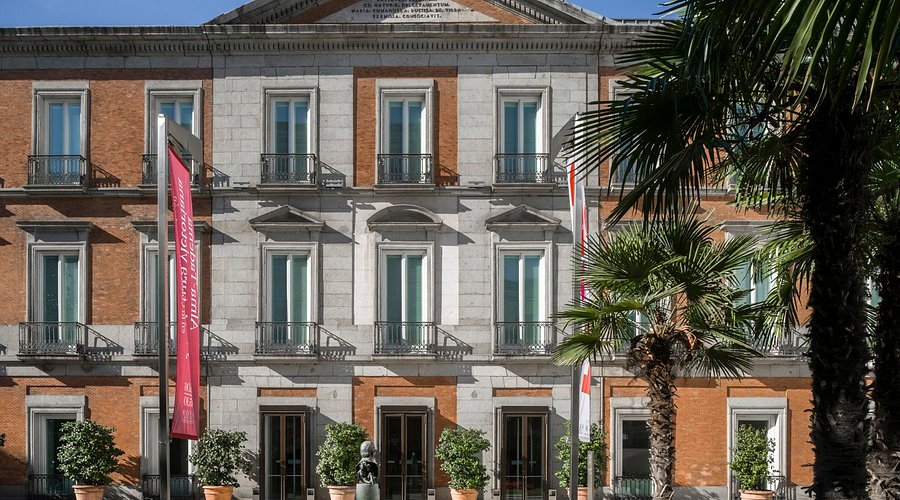
Situated along Madrid’s famed Paseo del Prado, the Thyssen-Bornemisza Museum complements the Museo del Prado and Reina Sofía to complete the city’s celebrated Golden Triangle of Art. Originally a private collection amassed by Baron Heinrich Thyssen-Bornemisza and expanded by his son, Baron Hans Heinrich, the museum today houses nearly 1,000 masterpieces spanning from the 13th to the 20th century, including works by Dalí, Degas, Rembrandt, Renoir, van Eyck, and Van Gogh.
A Family Legacy in Art
The collection began with August Thyssen, a German industrialist, and grew over generations. Heinrich Thyssen-Bornemisza enriched it further, acquiring works like Jan van Eyck’s The Annunciation and Caravaggio’s Saint Catherine of Alexandria. His son, Baron Hans Heinrich, added avant-garde and modern art, opening the family gallery in Lugano to the public before relocating the collection to Spain in the late 20th century. Today, many paintings remain part of the Carmen Thyssen-Bornemisza collection, loaned to the museum by the Baron’s widow.
Explore the Collection by Floor
Second Floor: Medieval and Renaissance art, featuring Italian, German, and Flemish religious works, masterpieces by El Greco, Tintoretto, Titian, and Spanish masters Zurbarán and Murillo. Dutch and Flemish greats like Rembrandt, Rubens, and van Dyck also shine here.
Top Floor (Rooms A-H): The Carmen Thyssen-Bornemisza collection, showcasing works by Boudin, Canaletto, Courbet, Fragonard, Matisse, Picasso, and Renoir.
First Floor: 19th-century French Impressionist and Post-Impressionist paintings by Cézanne, Degas, Gauguin, Pissarro, Toulouse-Lautrec, and Van Gogh.
Ground Floor: 20th-century modern art, including Cubism, Surrealism, Pop Art, and Expressionism, with works by Picasso, Braque, Miró, Dalí, Lichtenstein, and Pollock.
Unique Thematic Tours and Vibrant Atmosphere
The museum offers special themed tours focused on topics like food, wine, fashion, or love, perfect for visitors short on time. Known as “Everyone’s Museum,” it fosters a lively, welcoming vibe with open-air concerts, rotating exhibitions, educational programs, and free entry on Monday afternoons.
Practical Information
Tickets (EUR 13 full access, EUR 18 with audio guide) should be booked online in advance, especially for weekends. Free admission is available Mondays from noon to 4 pm. After your visit, unwind at the museum’s lobby or open-air terraces, perfect for enjoying cocktails amid art-filled conversations.
WhatsApp us